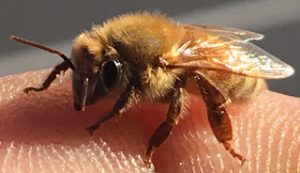 |
| It is all about saving honey bees |
Each fall I post on social media, in my local area that if beekeepers have colonies that they do not believe will survive the winter, I will take the bees and they can keep the equipment and frames. This allows them to harvest honey and not worry about trying to the bees alive all winter. A few days ago, a lady answered the call and I visited her family Sunday. My incentive is to acquire small colonies that I can care for and heal, and take through the winter months. I have successfully taken tiny colonies through winter that others would have abandoned.
Once I arrived, I determined the colony could survive with a bit more care by the worried beekeeper. My inspection and suggestions are as follows:
Inspected a new-be hive today. Beekeeper felt that the colony was weak and would not survive winter. Winter here in Utah really is only 2 months. Did a full inspection without a suit or gloves.
This colony started as a package this spring, swarmed once. Was a double 10 frame deep with 1 gallon frame feeder. The 17 frames were mostly drawn out. About 8 frames of bees and 6-7 frames of capped brood. Uncapped brood showed eggs, royal jelly, and bright white larvae. The capped cells were in a large oval, with no perforations or empty cells. Scarce nectar reserves, and scarce pollen / bee bread stores. No wilted wing, no obvious issues other than NO food reserves. Bees very mild and very active – I counted 78 bees returning in a minute. Bees would leave and return on 3 inches of far end landing board. All edges of the boxes had adequate propolis for winter sealing and was still quite sticky.
My recommendation: reduce hive to one box for a week and place all brood frames in one box with frame feeder. Feed bees fall syrup and Power Patties. Reduce entrance to upper and 2 fingers on lower entrance. This will allow the bees to successfully defend this time of year. In a week add the second box under the current box as they will be bursting. With 6-7 frames 3/4 filled with capped brood, this can double the size of the colony when they all hatch. Oxalic acid vaporizer now, then again in 10 days. Feed until frost, in a month stop liquid feeding then add a candy board on top. Keep the frame feeder inside but leave empty. At snow fall open lower entrance up so winter die-off does not trap bees inside. In winter, if you see bees flying check to see if the candy board is adequate- if not add more. You need to keep the bees alive inside for about 2 months. Don’t wrap or change anything else prior to snow. This colony will have second box done by mid November. This colony can survive the winter.
The brood will hatch within 10 days, the queen will lay it all again and will hatch in 26 days or end of October. If the season holds out like it has the last few years, another hatch could come. As long as this colony can build up stores, it can make it.
Afterwards I received a wonderful response on social media from this family:
I am overwhelmed by the kindness of Albert! I contacted him to invite him to take my bees because I didn’t think they would survive winter but as it turns out we might be able to get them to survive the winter if we follow his expertise. He spent an hour with me educating me about all things bees and even gifted me with some of his honey. Seriously grateful for this act of generosity and apiary awesomeness. Way to share the bee love! Thank you!
I was also asked afterwards about my recipe for candy boards for winter. First off, bees can digest and prefer crystallized sugars for winter. Ideally the honey that was created has crystallized, as not to create excessive moisture during the winter isolation in the hive. I support the use of candy boards, but I add an ingredient others perhaps do not. The Complete Bee supplement added to the mix gives nutrition to the winter colony. My recipe is as follows:
12 cups sugar (I use cane sugar, but many use inverted sugar),
3/4 cup water,
2 cap fulls (1 tablespoon) Complete by Complete Bee.
Mix until completely blended. Press and let dry one day.
